Has all the air in the world been breathed before? Are any viruses beneficial to health? Can naked farts transmit diseases? You set the agenda in this Naked Scientists Question and Answer show in which we also discover how Inuit cope without fruit and veg, whether muscles can become cancerous and how long before we can teleport to work. Plus, reproducing Alzheimer's disease in a dish, self-distilling vodka, magnetic soap to cleanse the parts other soaps can't reach, and what magic mushrooms do to the brain...
In this episode

- Is there a limit to human performance?
Is there a limit to human performance?
Kat - In terms of evolution, it's really hard to see because, being able to run a race really fast isn't actually that important for our survival as a species unless we start killing people who can't run fast enough, that might work. I think just in terms of the physical human body, there may well be - and this is assuming we're not talking about any invention of wonderful drugs which might make people go faster, or manipulating our biology because that might be considered to be cheating. I think that unless you can actually start breeding people significantly taller or stronger, we are possibly going to reach a limit. People like Ray Kurzweil and a lot of the futurists say, well there's just going to become a point where we'll have to transcend our biology and start mixing our own tissues with technology and then probably, we'll see another leap in people going faster. But again, is that cheating? I don't know.Dave - I guess the one kind of evolutionary thing which might work is if effectively we end up selectively breeding people to run faster. If the fastest runners start breeding with each other then on average, their children will be faster and some of those might be even faster than their parents. So I guess the only way it might carry on improving, is if athletes keep breeding with each other and not with the rest of us.Chris - I suppose to a certain extent, that's kind of already happened - this selective breeding. Because if you look at who wins the London marathon every single year, it's always a wiry Kenyan, because they generally have over generations, growing up in a high mountainous area where the environment has put enormous selective pressure on them to be exceptionally geared up to run long distances very fast. I mean, they run a marathon in the time it took me to do half a marathon and they were sort of able to do that and not look too bad after, but I'm not even close. I mean, Kat you did the Race for Life and stuff, don't you?Kat - Yeah, I've done my share of half marathons actually, very, very slowly. I am tiny and stumpy, but again, it's interesting because marathon running and the kind of sport as a discipline, it's very rarefied so I don't know how much of a real selective pressure there is in daily life which therefore you would have to have a special athlete breeding programme to really get many significant more improvements, I think.Chris - I also wondered to what extent it comes down to cheating because what do we define as cheating? At what point do you call eating a diet which is informed by science in a training regimen informed by science and having footwear which has been built informed by science - to what extent does that constitute cheating? If you had those gadgets compared to people who were doing those races 50 years ago, they would I think justifiably answer or say that you had a number of advantage?Kat - Yeah and you've got all these interesting things like a kind of blood doping and stuff like that, and even a lot of athletes will go to high altitude to train because it makes more haemoglobin, more red blood cells in your body, so you can use oxygen more efficiently and is that cheating? It's certainly considered cheating when people start injecting themselves with chemicals that make more red blood cells. So, very interesting to see where sports medicine is going to go and where performance is going to go, and especially if there's such widespread use of pharmaceuticals to help improve performance.

How do Inuit cope without fresh vegetables and vitamin C?
This is a great question because obviously, there isn't really a lot of fresh fruit up in the Arctic. In fact, there is a lot of evidence to suggest that the traditional Inuit diet does have vitamin C in it. It's not as much as you would get with a diet that's very rich in fruit and vegetables, but clearly, it's enough to keep them healthy because the Inuit are healthy. They're not affected by scurvy.
One of the theories is that it's actually the raw meat and fish, the main component of their diet, which does have a significant amount of Vitamin C in. The Inuit living on fresh raw meat and fresh raw fish would actually manage to get enough vitamin C, and particularly, there's a lovely traditional Inuit staple called muktuk which is the skin of the beluga whale, and this has a lot of vitamin C in it. Also, the organs of sea mammals and, apparently, the stomach contents of caribou, though I'm not sure they would actually eat that - maybe they just fed it to the dogs!
There has been quite a lot of research looking at traditional Inuit populations and their diet and there clearly is enough vitamin C when you analyse their traditional food sources.
The problem comes when people are moving away from their traditional food sources and not getting enough fresh fruit and vegetables in return. I found a lovely paper from 1975 which does show that there is some evidence of vitamin C deficiency in the Inuit population. That may be some affect of their diet, but overall, because there isn't widespread scurvy, we have to assume that they are getting enough vitamin C from their traditional diet.

Has all the air in the world been breathed before?
Dave - It rather depends what you mean by not being breathed before. If you're only interested in the molecules not having been breathed in before - and specifically if you're interested in the oxygen and nothing else - then any oxygen molecule you're breathing in either hasn't been breathed before at all - or it can't have been breathed more that a few times, because otherwise it wouldn't be oxygen anymore it would be carbon dioxide! But, if you're thinking about the actual atoms and whether any of the atoms have ever been breathed before, that's a whole different kettle of fish.
Chris - Because they're being recycled around the Earth all the time, aren't they? In the sense that a plant makes some oxygen, you breath it in and mix it with some sugar to make it into carbon dioxide, that comes back out and the plant breathes that back in and recycles all these atoms again and again.
Dave - That's totally right. I was just doing some calculations. It takes about 2,000 years for all of the plants in the world to work their way through all the oxygen in the atmosphere. So, some of the molecular oxygen you're breathing in won't have been breathed in before. But because the Earth is about 3.8 billion years old, you would have thought that pretty much all of it will have gone through plants and creatures in the past. But then again, I wouldn't say for definite that all of the atoms, all the molecules that you breath in have been breathed before, because there are 6 with 23 zeros (6 x 1023), or maybe as low as maybe 3 with 23 zeros (3 x 1023), molecules of gas in every lung full of air, and some of those might well have just been sitting there since the beginning of the Earth.
Also, some atoms have been coming out of volcanoes or degassing out of the centre of the Earth, and some have been raining in from space. So, in a normal breath, a few atoms won't have been breathed before, but I think most of the air will, wherever you are.
Chris - When you say Earth is 3.9 billion years old, you mean life on Earth is 3.9 billion years old because the Earth itself is a little bit older than that?
Dave - Yeah, definitely. So, creatures have only been breathing stuff for 3.9 billion years.
Why don't people get muscle cancer?
It's not true. There are some quite common myths about certain types of tissue in the body that don't get cancer. People say, "Oh, you don't get cancer of the heart." You can, it's just incredibly rare. Any of the tissues of our body can pretty much become cancerous because that's just what happens when cells grow out of control. There are well-known cancers of the muscles. There are benign muscle tumours of the smooth muscle. That's the kind of stuff around our intestines and the female uterus. They're called leiomyomas. You also get benign tumours of skeletal muscle, those are rhabdomyomas and you can also get malignant aggressive muscle tumours. So you get leiomyosarcomas and that's the smooth muscle cancers. And rhabdomyosarcomas which particularly affect children, and those are all cancers of the muscle. So although these are very rare, they still do happen.
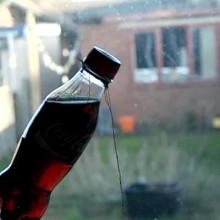
Which Thread Breaks? Using inertia to your advantage
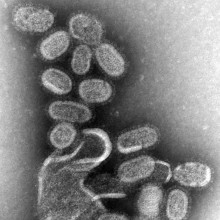
Are there germs in bad smelling air?
Chris - I have been thinking about this and I think there are probably two aspects. On the one hand, you could say no. On the other hand, you could say, yes!
Let me explain why I'm hedging my bets here. First of all, what is a smell? A smell is a molecule of some kind which is in the air that travels into your nose. Its gets to the top of your nose where you have something called an olfactory epithelium.
There, there are nerve cells that have chemical docking stations called receptors that lock onto that molecule. These tell the nervous system, "I recognise this molecule," and therefore, signal to the brain that this smell is present.
Molecules in their own right are not going to harm you, unless they're a toxic molecule, like hydrogen sulphide for example. That smells of rotten eggs and it's also a bit toxic; but a molecule on its own is not going to infect you with something. But it could, on the other hand, have come from a source of infection: if there's a corpse or something rotting nearby and it's pumping out these molecules, if you can smell them, the source of that smell - microorganisms - is going to be quite nearby. So, you should therefore possibly watch out.
At the same time, and this is where my "yes, it could be a threat" answer comes in - it may be possible also for your nose to detect the physical presence of microorganisms directly. Let me explain that and use an example that probably everyone is acquainted with.
The last time there was a sudden rain shower and you went out of your house and you sniffed the air, you must've noticed that wonderful aroma. It's a clean, fresh, earthy aroma in the air. This exists because when the raindrops come down, they hit the soil and liberate from the soil lots of little spores of an organism that lives in the soil. They're spores from a family of bacteria called Actinomycetes.
On the surfaces of these spores there are molecules which will dock with the receptors in your nose and trigger you to smell that smell. So, what you're smelling, which you think is beautiful fresh post-rain air, is actually loads of microbial spores. Therefore, if you can smell these bacteria by detecting parts of these bacteria, you could argue that it's possible that if you can smell a smell, there could be something potentially infectious in that air, and that could potentially hit you and infect you.
So I reckon the answer is that most of the time, a dodgy smell isn't going to be a risk, but it could signal that there's a risk nearby and so, you could walk into a risk if you weren't careful.
Dave - Are there any pathogenic, dangerous, bacteria which have this spore effect?
Chris - Yes, there are loads of them. The other thing is that Norovirus, which is a very tiny particle just 30 nanometres across - one 30,000th of a millimetre - causes diarrhea and vomiting, and winter vomiting disease. In anyone who's infected with Norovirus, every millilitre of what comes out of their body (at either end) contains about 100 million of these virus particles. They are smaller than the particles of smoke that come off a cigarette. So the chances are, if you smell the smell of "the product of someone having a Norovirus episode", some of the particles from that are drifting around in the air and they're certainly on surfaces in the environment. If you breathe them in, the infectious dose is one or two particles, so you're probably going to get it...
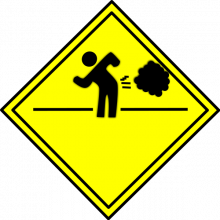
Would filtering farts prevent hospital acquired infections?
Chris - This is a question that we answered a few years ago and Ben Valsler went to see Simon Park, in Surrey, who actually did the experiment for us and we've got the bit of audio from 4 years ago in 2008 where they did the experiment to see how efficiently farts can spread potential pathogens.
Ben - We know that coughs and sneezes can spread diseases and that's how many respiratory infections actually get transferred, but you were thinking there might be another way that bacteria could be transmitted.
Simon - Yes. I have two sons, Joe and Josh and they've developed a sort of obsession with this homemade biological prank of farting and I thought, why do we find this so offensive and why is it dangerous, and can I demonstrate this to my children to stop them doing it?
So I thought of some experiments where I could actually prove whether or not farts could transmit bacteria. So, what I've done is taken some agar plates that are very good at culturing faecal bacteria and done some very crude experiments where we've exposed the plates to people farting in terms of a naked fart with no pants and no jeans on, and also, people farting with underpants and jeans on.
Ben - So you've set this up by passing wind shall we say, on what's called a MacConkeys agar plate. One of them clearly has some colonies on and the other one looks completely clean. So, Simon, which one is which?
Simon - The plate that's totally clean is one that was exposed with pants and jeans on, so it's obviously the pants and jeans are being very effective at filtering out any faecal bacteria, but the plate that was exposed to the naked emission has a splattering of red colonies on it and they are very indicative of E. coli that's a very common faecal bacteria. That's a good indicator of faecal contamination. There's such huge numbers of bacteria in a stool that it's inevitable that we will transmit bacteria after flatulence.
Chris - So the bottom line is - if you excuse that pun - if you cover the area, as someone hopefully in hospital staff and patients would be expected to be, then the infectious transmission risk is probably extremely low. If you go around flatulating on people in hospital without the rear uncovered, there is a likelihood you may expel some organisms that could make people unwell.
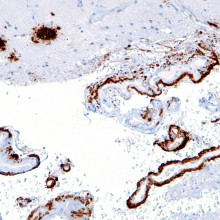
15:31 - Stem cells provide Alzheimer's clues
Stem cells provide Alzheimer's clues
One of the biggest problems with studying brain diseases such as Alzheimer's is the difficulty of getting samples of living brain cells from patients, and finding good model systems that be studied easily in the lab. There are some mouse models of Alzheimer's which have been very useful, but these don't copy all the symptoms and changes that are seen in the human disease.
Most studies of Alzheimer's disease using human tissue have been done using samples from people with a rare inherited forms of Alzheimer's, but actually the vast majority of cases are randomly-occurring, or sporadic, forms of the disease. There's also been a bit of work done using nerve cells from human foetuses, but there are ethical and technical issues with using this kind of tissue.
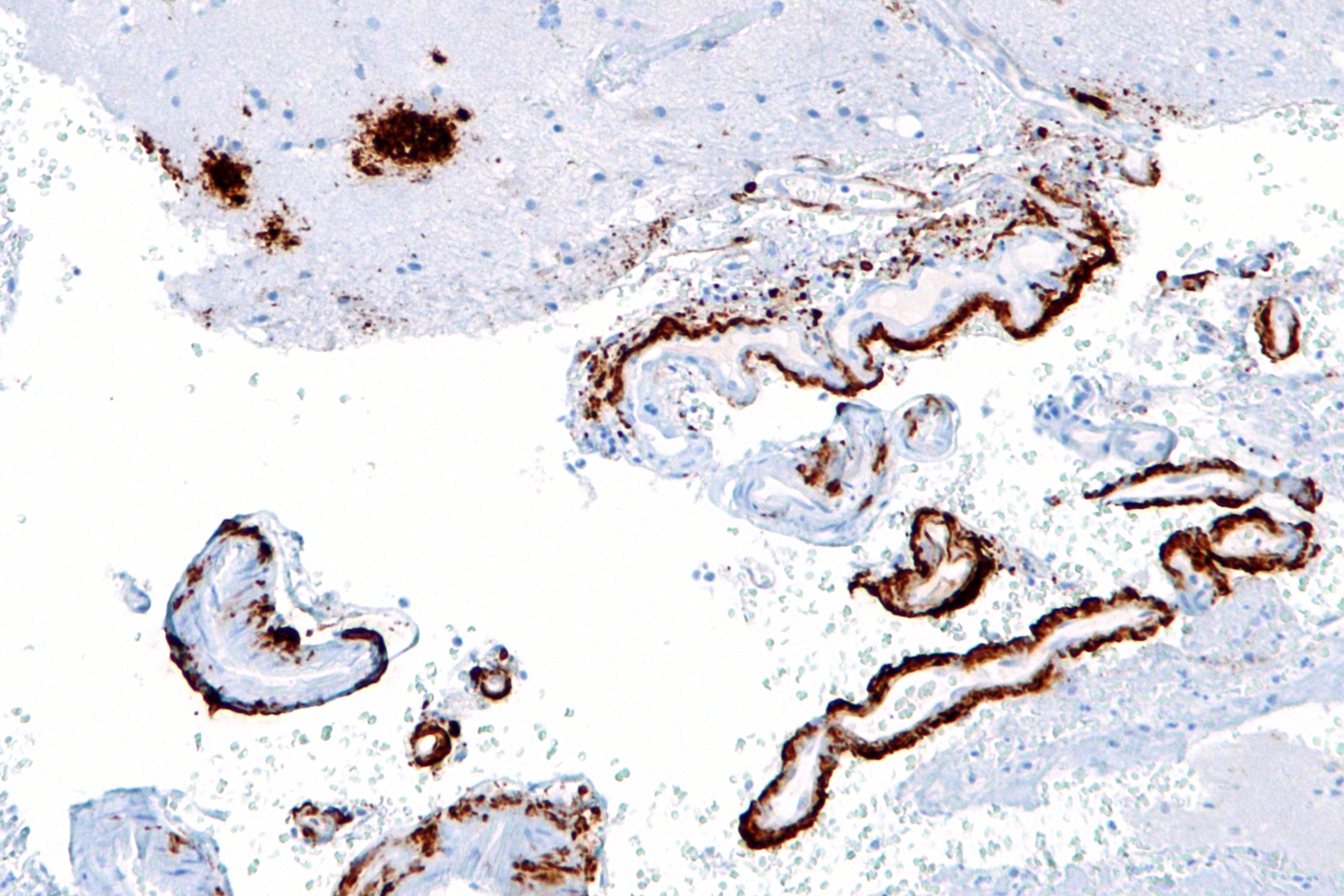 Now researchers led by Mason Israel and Lawrence Goldstein from the Howard Hughes Medical Institute in California have published a paper in the journal Nature, revealing a way to generate stem cells from Alzheimer's patients, which can then be grown indefinitely in the lab.
Now researchers led by Mason Israel and Lawrence Goldstein from the Howard Hughes Medical Institute in California have published a paper in the journal Nature, revealing a way to generate stem cells from Alzheimer's patients, which can then be grown indefinitely in the lab.
The researchers started by taking small samples of skin from two patients with an inherited form of Alzheimer's disease, two patients with randomly occurring, sporadic Alzheimer's, and two people without disease. Then the scientists separated out specific cells called fibroblasts from each skin sample, which can be grown in dishes in the lab for a limited time.
Next, they used a relatively new and very exciting technique, using a special virus known as a retrovirus to deliver a particular suite of genes into the fibroblasts, which transformed them into immortal stem cells. These cells are known as pluripotent stem cells, because they can be converted into several different types of cell.
Next, the researchers grew these pluripotent stem cells under certain conditions that cause them to grow into nerve cells, or neurons - the kind of cells that are affected in Alzheimer's. Studying these cells in depth showed that the neurons grown from samples taken from patients with hereditary Alzheimer's had high levels of amyloid - a protein that makes the plaques that are the main characteristic of the disease. They also found higher levels of a protein called phospho-Tau, which makes knotty tangles in the brain of patients.
Intriguingly, they also found higher levels of amyloid and phospho-Tau in neurones made from cells from one of the patients with sporadic Alzheimer's, even though the patient's original fibroblasts didn't show increased levels of the molecules. This tells us that there must be some kind of gene variations or faults in the patient's genome that are causing the disease, although at the moment the identity of these genes is unknown, so using this kind of technique to study cells from many more patients with sporadic Alzheimer's could provide really important clues to why some people develop the disease.
With experiments like this, there's always a risk that manipulating the cells in the lab could introduce unexpected gene faults that confuse the results. At the moment it's not clear whether that's happened at all here, and only will time will tell exactly how effective these pluripotent cells are a model for studying Alzheimer's in the lab. But for now it's certainly an important tool that researchers can take forward, and should hopefully provide more clues as to how Alzheimer's develops, and how it might be treated or prevented in the future.
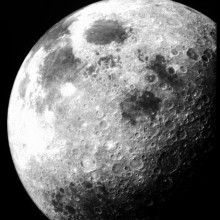
19:19 - The Magnetic Moon
The Magnetic Moon
with Erin Shea, MIT
Chris - When Neil Armstrong and Buzz Aldrin brought back the first samples of Moon rock in 1969, scientists were surprised to see tell-tale signs in material that the Moon had once had a magnetic field - a bit like the one that we have on Earth today. They thought that this magnetic field was created by geological processes that were occurring while the Moon was still hot from its birth, but that these had stopped once it had cooled down. Now though, another look at one of those 1969 samples has revealed something very unexpected. Erin Shea from MIT made the discovery. She is with us now. Hello, Erin.
Erin - Hello.
Chris - So what is it you found?
Erin - What I found was that 3.7 billion years ago, the Moon had a very strong, stable and long-lived magnetic field - like you said, similar to what the Earth has today.
Chris - If we wind back through the Moon's history, we think it's about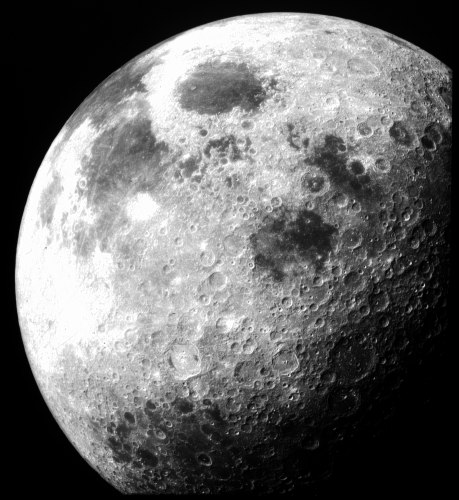 the same age as the Earth - give or take - and it was formed by some catastrophic collision between Earth and an Earth-sized planet that then ejected all this material into space. So, is the Moon therefore effectively a mini Earth in orbit around the Earth?
the same age as the Earth - give or take - and it was formed by some catastrophic collision between Earth and an Earth-sized planet that then ejected all this material into space. So, is the Moon therefore effectively a mini Earth in orbit around the Earth?
Erin - In a lot of senses, the Moon and the Earth have a lot in common. They both have these metallic cores. On the Earth, thankfully, it's still going strong and producing our magnetic field. On the Moon, it seems like it died out several billion years ago.
Chris - But grossly, the mechanism that produces the magnetic field, we think would probably be similar, because the Moon has effectively spawned from the Earth.
Erin - Initially, we thought that if the Moon ever did have a magnetic field caused by a dynamo, which is what generates the magnetic field on the Earth, that dynamo would have the same power source on the Moon as it did on the Earth. What our study has just shown though is that the dynamo on the Moon lasted far longer than we would've expected it to if it had the same power source. On the Earth, the dynamo is driven by cooling. Basically, as the metal cools down, it convects the metallic core and that generates a magnetic field through some complicated physics. On the Moon though, we would've expected the Moon to cool off long ago, 4.2 billion years ago approximately. So seeing evidence for a magnetic field 2.7 billion years ago really kind of puts the alarm bells out that something other than cooling must've generated the moon's dynamo.
Chris - There's no way that you could've miscalculated or - I don't mean you, personally, but the scientific community could've miscalculated the rate of cooling for the Moon and that in fact, it is the same processes we have on Earth, it just took longer for the moon to cool down and therefore it kept its dynamo for longer?
Erin - Well, as a scientist, you can never say never, but I think it's rather unlikely that we misjudged this calculation. We know how much heat producing radioactive elements the Moon has, we know how big the Moon is, and so, from there, we can actually do this calculation. So probably not, but I would never cross that completely off the list.
Chris - So how did you actually do the study? You got your hands on a piece of material that Buzz Aldrin and Neil Armstrong brought back with them from 1969. I bet they don't come along every day.
Erin - No, it was like a dream. You apply to NASA and tell them what you're going to do with the sample and then they allocate you a given amount. We got one gram of lunar sample 1OO20, and we cut this into small pieces and measured the magnetic field on each of those pieces. We knew their orientation relative to each other, which is important for the measurements that we were doing.
Chris - So you can tell that there's a magnetic field written into that rock. How did it get there then?
Erin - There are lots of ways that rocks can acquire magnetic fields. On the Earth, when lava erupts, it can acquire a magnetic field from the Earth's magnetic field because you know, that's the reason that our compasses work. Then that rock could get hit by lightning and then it would get another magnetic field. On the Moon, there's a whole different set of sources. So, we have possibilities that lava was erupted onto the surface of the Moon and it cooled down in the presence of a magnetic field generated by a dynamo, and that would produce one set of characteristics. Another set of characteristics would be produced if there was a big impact and a magnetic field was produced by that impact. When we picked that sample up, it spent about 3 days riding back to the Earth on a spacecraft with DC current which also generates a magnetic field. It then spent 4 years sitting on the surface of the Earth in the presence of the Earth's magnetic field. There are all these sources and then lots and lots of different things in addition to that, that could've given this rock the magnetic field, and what we've shown is that this sample actually erupted as a magma. It was hot and then as it cooled down, it locked in a magnetisation that it seems was from a lunar dynamo, which is awesome.
Chris - So it's a time capsule effectively tracing a snapshot in time of the Moon's early history and recording the existence of this magnetic field a long while after we would've expected it to have gone away. Can you speculate for us as to how that came along? How did it come about? What could've caused this?
Erin - What could've caused this dynamo on the Moon? Obviously, we just talked about cooling and you're right, we don't know for sure. But we're pretty sure that the Moon would've been cooled by 3.7 billion years ago. There were two papers written and published in Nature in December that talked about different ways that you could've generated a lunar core dynamo. One of which was that the Earth of mechanically mixed the lunar core, the gravity of the Earth forced that around. This is really neat to think about because 3.7 billion years ago, the Moon was actually much closer to the Earth, so would've had a much bigger effect. The other paper was about large impacts, because when you look at the Moon today, you can tell that it's experienced a pretty rough history. There are lots of craters on the surface and what these people hypothesise is that maybe large impacts served to stir that lunar core and generate a dynamo.
Chris - And finally, does it have any implications for the Earth? It's one thing to worry about the moon where no one lives, but we live and die by our magnetic field. What about life on Earth? Does it tell us anything about the magnetic field here?
Erin - What it might tell us is, what does a magnetic field look like when it dies off? That's something it could tell us. And then also, what started this on the Earth? What was the Earth's early history like because if the Moon is full of craters then the Earth must've been bombarded with craters too. And so, what effect would that have had on the Earth's magnetic field and its early history?
How do mutations occur in human beings?
Mutations are damage to the DNA of your cells. DNA is obviously the instructions for your cells, telling them what to do, so damage to DNA in your cells can cause problems. Most mutations happen because we breathe oxygen. But don't stop breathing, you'll probably going to be okay! Breathing oxygen generates molecules called free radicals within ourselves and these are very damaging to DNA. Most of the mutations that we get are just patched up all the time. We have very good DNA repair processes in our cells that fix them, but sometimes mistakes creep in. Most of the time, these aren't even important because a lot of the cells in your body are destroyed after a while. The cells in your gut are constantly turning over, also in your skin, and your bone marrow... So most of the time, mutations are not that important. Cells get damaged and they just die and you get rid of them. What happens when it becomes really important is when you get mutations in cells that do hang around and in stem cells particularly that can cause problems. But there are lots of other ways that you can mutate the DNA in your cells. For example, the carcinogens, the cancer causing chemicals and things like tobacco smoke. Some things in our environment, some things like benzenes, some air pollution, all sorts of things can damage your DNA. Another big cause is the Sun. The ultraviolet light from the Sun causes a very specific type of DNA mutation. It causes the Thymine bases (the 'T's') that are nearby to fuse together in your DNA.
So there's an awful lot of things that can cause mutations. Sometimes they don't matter, sometimes they do. Some of which we can't prevent and a lot of which, our body just repairs naturally. But the trouble is, when we don't repair them or we keep piling more mutations, or if we have problems with the repair systems in our cells, then you can get problems like cancer and other diseases.
Will we soon be able to teleport?
At the moment there are some people doing incredibly subtle experiments which mean you can get all the information about a single particle - its position and its direction - and then translate that information to somewhere else. This research is still happening on single photons. I think doing the same for a whole person certainly isn't going to happen in our lifetime.
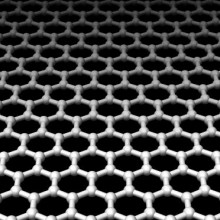
28:45 - Self Distilling Vodka
Self Distilling Vodka
Graphene is probably the material of the moment, it is made up of carbon atoms bonded to one another in a honeycomb pattern forming extremely strong sheets. These sheets can be stable at just one atom thick, and have very exciting electrical properties, but are also remarkably impermeable to other atoms...
Members of Professor Sir Andre Geim's group at the University of Manchester, where graphene was first identified, were investigating the permiability of a closely related material called graphene oxide. This is graphene which has been reacted with a strong oxidising agent, making it more soluble and easier to deal with.
They created membranes made up of small pieces of graphene oxide which pile up like bricks to form an interlocked structure, and then tested how gas-proof they were by using the film as a lid for a container full of various gases.
They found that despite being 500 times thinner than a human hair, it completely stopped Hydrogen, Nitrogen and Argon from escaping, to the limits of their measurements. It even stopped Helium which, being a tiny single atom will escape from party balloons very quickly, and can even diffuse out through a millimetre of glass.
They then tried various liquids, and found similar behaviour for ethanol, hexane, acetone, decane and propanol vapour, but when they tried normal water it behaved as if the membrane wasn't there, escaping at least a hundred thousand times faster than any of the other materials. They think the water is forming a layer one molecule thick between the layers of graphene, blocking the route for everything else, but if it dries out, this gap shrinks and seals up.
To make use of this behaviour they put some vodka in the container, and left it for a few days. Normally ethanol evaporates faster than water so vodka gets weaker over time, but with their membrane, which blocked the ethanol, the vodka got stronger and stronger.
This is extremely interesting behaviour, as seperating water from other solvents is a huge part of many chemical processes. This is normally done by distillation, which takes a large amount of energy, and the process has to be repeated many times. Ethanol cannot be concentrated to more than 96% without involving poisonous solvents to remove the water, so this material has a huge potential.
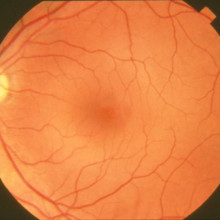
31:48 - Embryonic stem cell treatment improves patients' vision
Embryonic stem cell treatment improves patients' vision
In two blind-registered American patients, an injection of retinal pigment epithelium made from human embryonic 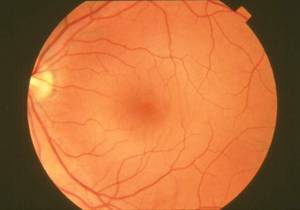 stem cells has partially restored vision.
stem cells has partially restored vision.
A case report in the Lancet medical journal describes the procedure carried out on the two volunteers who were both suffering with degenerative conditions (Stargardts Macular Dystrophy and age-related macular degeneration) that cause the cells in the retina to die off, leading to progressive sight loss and, as in these patients, eventually blindness.
This occurs primarily because a specialised cell layer called the retinal pigment epithelium, which nourishes the light-sensitive rod and cone photoreceptors in the eye, breaks down. Robbed of these supporting cells, the photoreceptors eventually follow suit and degenerate.
But if the retinal pigment epithelium can be replaced, it should be possible to rescue the rods and cones before they succumb, preventing vision loss.
But making new pigment epithelium is not trivial and is most easily achieved using embryonic stem cells which can be pursuaded to turn into the correct cell types by culturing them under the right conditions.
No one knows, however, how effective, or safe, cells produced in this way might be, although tests in laboratory animals genetically engineered to develop similar sight-loss syndromes to humans have been very encouraging.
To address this question, a US team of doctors and researchers, including Massachusetts-based stem cell scientist Robert Lanza from the company Advanced Cell Technology, used human embryonic stem cells to produce fifty thousand new retinal pigment epithelial cells that were injected into one of each of the patients' eyes.
Four months later, examination of the injected eyes showed improved pigmentation visible in their retinae, suggesting that the cells had remained viable, and both patients had objective improvements in their vision. One patient was even able to count the number of fingers held up by the examiner having previously been able to distinguish only gross movements of a hand being waved at them.
Critically, neither patient showed any ill effects as a result of the procedure nor any reduction in visual function, although both were given immunosuppression to prevent rejection of the foreign stem-cell derived tissue.For how long, if at all, they will need this though, isn't known.
According to Robert Lanza, "Despite the progressive nature of these conditions, the vision of both patients appears to have improved after transplantation of the cells. This is particularly important, since the ultimate goal of this therapy will be to treat patients earlier in the course of the disease where more significant results might be expected...

36:02 - Seeking Out Storms - Planet Earth Online
Seeking Out Storms - Planet Earth Online
with Professor Robin Hogan, Reading University
Robin Hogan, a professor of atmospheric physics at the University of Reading, is working with the Met Office on a project to develop a statistical database of storms. It's called DYMECS - Dynamical and Microphysical Evolution of Convective Storms - and involves real-time analysis with the aim of helping to improve storm predictions in the future.
Planet Earth podcast presenter Sue Nelson met up with Robin and asked him how you go about tracking a thunderstorm...
Robin - What we do is we use the Met office radar network and that takes images of the rainfall over the whole of the UK every 5 minutes. And from that, we can see with incredible detail what the surface rain rate is and we can see how we can track one storm from one 5-minute period to the next and workout where it's going and so typically, a storm will last for maybe an hour or sometimes 2 hours and so, we're able to see how that storm evolves and particularly how surface rain rates get larger as the s torm gets bigger, and then as it sort of breaks up later on in its life, it will then decay away. And we can use computer algorithms to follow that storm through its evolution.
torm gets bigger, and then as it sort of breaks up later on in its life, it will then decay away. And we can use computer algorithms to follow that storm through its evolution.
Sue - So, it's relatively easy to follow. How easy is it to simulate?
Robin - That's one of the biggest problems of predicting floods in the summer. A model of weather forecasting has to capture lots of different processes to get convective thunderstorms correct. It needs to represent things like hail stones, it needs to capture the updraughts correctly - that's the vertical winds that are carrying the particles up inside the cloud - and you often get combinations of super cooled water droplets, so this is droplets that are below zero degrees but they're still liquid and they will freeze at some point and the models have to capture the time at which that occurs and all of these processes are important for working out the surface rain rate which is what we want to get for flood forecasting, in particular.
Sue - So what is this project aiming to do then?
Robin - What we want to do is to use the capabilities of the Chilbolton research radar to capture the evolution of thunderstorms in much more detail than we've ever got before and that will then be combined with a modelling component, which will be using the Met Office's model, which has quite phenomenal resolution of the whole of the UK - it has a 1.5 kilometre grid box size - and by combining the observations and the modelling we're able to then see in which aspects the model isn't doing very well to hopefully improve it.
Sue - Why does it need improving? You say one and a half kilometres. That must cover even the smallest of villages.
Robin - Well even though it's 1.5 kilometres, models are only as good as the data that go into them and so it's relying on weather balloons that are only launched every 12 hours, for example, and the other thing is that the processes still have to be very much approximated. So, in particular, at 1.5 kilometres you are still having to represent the fact that as a convective storm - so a thunderstorm - rises through the atmosphere for example it will have to represent a mixing of air between the cloudy air and the clear sky next to it at just the right rate in order that the right amount of water gets up to the top of the troposphere, and if you don't get that right then the cloud will not go too high or it will go far too high and you will get the wrong amount of rainfall coming out of it.
Sue - So how do you improve then your measurements, your data, if you're only as good as the data you put in? How do you get better data?
Robin - The Chilbolton radar is really where we're coming from. So currently, when we see a weather forecast on the TV we see measurements by a number of radars around the UK that have a one degree beam width so their resolution at a distance of 60 kilometres is something like one kilometre. Now what the Chilbolton radar can offer is the ability to scan the three-dimensional structure, so not just the surface but also up to a height of around 10 kilometres which is typically how high storms get. This radar has a quarter of a degree beam width, so that means that at 50 or 60 kilometres distance it can see clouds with a resolution of 250 metres, so a much higher resolution. And the Chilbolton radar as well as being able to measure the intensity of rainfall is also able to measure the wind speed and so it can really see the flows of air that are acting to develop and build the storm.
Sue - Now you've been analysing various storms.
Robin - That's right. We have had something like eight very good days.
Sue - In your terms a good day then is a storm.
Robin - Absolutely! The more storms the better as far as we're concerned. We are hoping to get a total of 40 days over an 18-month period. We're actually interested in convective clouds in winter and summer so the Met Office also has a problem with snow showers, in particular, coming from the east so we're happy to study those when they come along and I'm sure we will be able to say some interesting things about the performance of the model there. So, we are hoping that flood forecasts can be made more skilful which is certainly of great economic benefit for the UK.
Are any naturally-occurring beneficial viruses?
I reckon the answer is yes. First and foremost, I think if you think about viruses that prey on bacteria because just like us, bacteria can catch a cold too. Bacteriophages will attack bacteria and kill them and this has actually been used as a form of antibiotic therapy and it was pioneered in Russia, but it has actually been used all over the world. What scientists do is find these viruses that discreetly and specifically prey on certain strains of bacteria and specifically the bacteria that's causing an infection in a patient. They can grow up those particular bacteriophages, they put them into the patient, they are unable to infect a person's cells because they lack the right docking system to latch onto one of our cells. They go into the bacteria, grow in the bacteria, each infected bacterium makes hundreds of new bacteriophages which then kill hundreds more bacteria, until it runs out of bacteria to kill, and then the whole thing just disappears. So I'd say those are pretty beneficial viruses. There are also some viruses which infect us which actually we think may, despite the fact we're getting infected by them have a beneficial effect on our health. There was a paper published in Nature in 2007 and it's by a guy called Skip Virgin in the States and they demonstrated that if they got mice and infect them with the rodent equivalent of glandular fever, which is a Herpes virus, or Cytomegalovirus, another Herpes virus, and then after the animals had cleared the infection, they challenge them with listeria or with bubonic plague, the mice were all fine. They all survived. If they challenged mice that haven't had those herpes infections first then they all died. And their theory is that because these viruses get into the body and they then establish a life-long infection what's called a 'latent infection' they in some way reprogramme the immune system and it's almost like the immune system is using the virus because it's got a very big genetic code in the virus, almost like a USB pen drive for priming the immune system in a way that it's forgotten how to do itself. So, I would argue that's probably one kind of beneficial virus too, but a very nice question.
Why can't I get a car window to fog up twice?
Dave - What's going on is that your fingers are greasy. When you draw on the window, you can actually see the grease left on the window, assuming it's clean to start with. Grease is hydrophobic, which means it doesn't like water, whereas glass is actually hydrophilic which means it does like water. When you breathe on the glass, water vapour in your breath is condensing to form droplets of water. This creates the foggy bit which scatters the light to make it look foggy.
It's a lot easier for a droplet to start on something hydrophilic than something hydrophobic. So on the glass, you'll get lots and lots of droplets forming. You'll get billions and billions of billions of tiny little droplets forming. Whereas on the grease, because it's so much harder to form droplets, you'll just get a few big ones and then those will grow much more and so end up being much bigger. It's much easier to see through a few big droplets than through lots and lots of tiny droplets, so it looks transparent on the bit which is greasy and not on the bit which isn't.Chris - And that's why it looks like you can't re-fog it. There is some water there but just all in big blobs, not little blobs.Dave - Yes, and they can merge together into a sheet of water which is entirely transparent.
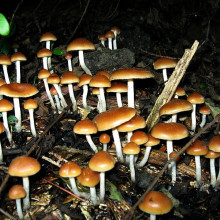
46:04 - Mapping a Mushroom Trip, Speedy genes and Magnetic Soap!
Mapping a Mushroom Trip, Speedy genes and Magnetic Soap!
with Robin Carhart-Harris, Imperial College London; Emmeline Hill, University College Dublin; Julian Eastoe, University of Bristol; Coren Apicella, Harvard Medical School.
Mapping a Mushroom Trip
How hallucinogenic drugs, such as magic mushrooms, affect the brain has been mapped in humans for the first time.
Using an fMRI scanner,, researchers watched how the brains of 30 volunteers responded to doses of psilocybin - the active ingredient of magic mushrooms.
The drug suppressed the activity of certain 'hub' regions of the brain that control how information flows between different brain regions. Areas known to control mood were also affected..
Robin Carhart-Harris, from Imperial College,
led the work.
Robin - The surprising result was that we only saw decreases in brain activity. We didn't actually see any increases anywhere in the brain. So the larger the drops in brain activity, the more intense the psychedelic effects of the drug. And then that they were in regions associated with the sense of self and also regions that's over active in depression because people are very self-conscious and self-critical in depression. The implication then is that the drug may be effective in treating patients with depression.
---'Speed Gene' unearthed in modern racehorsesThe
gene for speed in modern racehorses has been traced back toa single Mare that lived 300 years ago.
Since then, selective breeding for speed and stamina has led to a very high prevalence of a favourable "C-variant" of a gene called myostatin, which gives thoroughbred racehorses a sprinting boost.
Analysing the DNA of 593 horses from both Eurasian and north-American regions, Emmeline Hill from University College Dublin discovered where this speed gene came from in the first place and how it has spread.
Emmeline - The speed gene proliferation in the population is a result of the success of a horse called Northern Dancer. But also, the study shows how very quickly, economically valuable alleles can move within a population. This demonstrates that the power that breeders have to shape the diversity of the variation within their own populations and to be able to very quickly - with the knowledge of the genetic types of their horses - shape and develop a population of horses of the type that they want.
---
Attracting you with Magnetic Soap
The World's first
magnetic soap has been developed by scientists at the University of Bristol.
By combining iron-rich salts with the water-soluble component of soap, Julian Eastoe's team created soap particles with metallic centres meaning the soap can be controlled with a magnetic field.
Julian - There are various applications you can imagine. One which is quite obvious is the possibility to use magnets and these soaps to recover oil in oil spills for example. There are smaller scale applications. You can imagine trying to clean components of a machine or engine for example. Normal soaps could never get in to the nooks and crannies, but it now becomes possible using magnets to guide the soapy solutions into the parts which other soaps cannot reach.
---Hunter-Gatherer Social Networks
Social networks were crucial to the evolution of cooperation in ancient hunter-gatherer populations.
Studying how the Tanzania's Hadza people - who are one of the last surviving hunter-gatherer populations - Coren Apicella from Harvard Medical School found that ties between individuals were based on the tendency to cooperate and formed between both kin and un-related members of the group, leading to the altruism and cooperation also needed in society today.
Coren - Well a lot of the properties you see in our networks also hold true in the Hadza. Popular people tend to be friends with other popular people. You see a person's friends tend to be friends with one another. The further away you go geographically, the less likely you are to be friends with a person and cooperative individuals preferentially form ties with other cooperative individuals. So these findings provide crucial insight into the evolution of cooperation and altruism in humans and suggest that social networks have been a fundamental part of human life since ancient times.
The work was published this week, in the journal
Nature Communications.
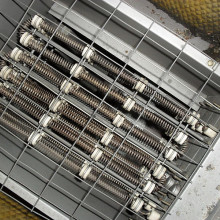
54:58 - Would turning off standby devices increase my heating bills?
Would turning off standby devices increase my heating bills?
We posed this question to Cambridge University's David MacKay...
This myth is true for a few people but only during the winter, but it's false for most. If your house is being heated by electricity through ordinary bar fires or blower heaters then yes, it's much the same as heating the house with any electricity wasting appliances. But if you are in this situation, you should change the way you heat your house. Electricity is a high grade energy and heat is low grade energy. It's a waste to turn electricity into heat. To be precise, if you make only one unit of heat from a unit of electricity, then that's a waste. Heat as called air source heat pumps or ground source heat pumps can do much better, delivering 3 or 4 units of heat for every unit of electricity consumed. They work like a back to front refrigerator, pumping heat into your house from the outside air. For the rest of us whose homes are heated by fossil fuels or by biofuels, it's a good idea to avoid using electrical gadgets as a heat source for your home. At least for as long as our increases in electricity demand are served by fossil fuels. It's better to burn the fossil fuel at home. The point is, if you use electricity from an ordinary fossil power station, more than half of that energy from the fossil fuel goes sadly up the cooling tower. Of the energy that gets turned into electricity, about 8% is lost in the transmission system. If however, you burn that fossil fuel in your home, then more of the energy goes directly into making hot air for you.









Comments
Add a comment